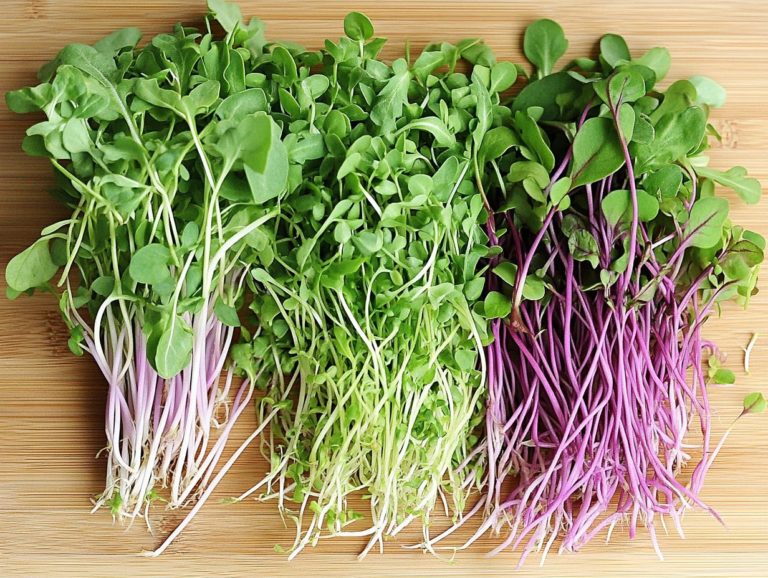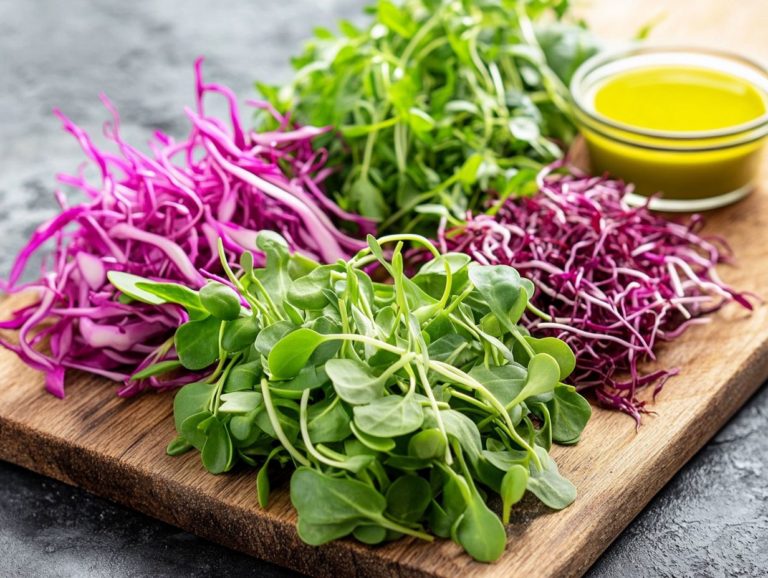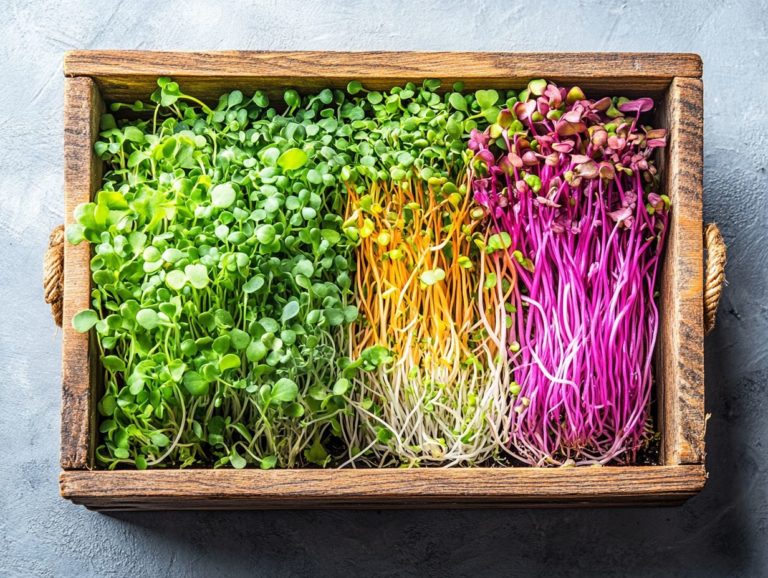Top 10 Microgreens for Weight Loss
Microgreens may be small, but they are mighty! They offer a nutritional punch that can truly transform your weight loss journey.
In this article, you’ll explore the top 10 microgreens, featuring favorites like broccoli, kale, and sunflower. You will uncover their unique health benefits, including their effects on heart disease and diabetes management.
Learn how these petite greens can assist in shedding those extra pounds and discover the best ways to integrate them into your meals. You will also pick up valuable tips for cultivating them right at home, such as using young vegetables like fenugreek and dandelion.
Elevate your meals and enhance your health today!
Contents
- Key Takeaways:
- 1. Broccoli Microgreens
- 2. Kale Microgreens
- 3. Arugula Microgreens
- 4. Cabbage Microgreens
- 5. Radish Microgreens
- 6. Pea Shoots Microgreens
- 7. Mustard Microgreens
- 8. Sunflower Microgreens
- 9. Beet Microgreens
- 10. Watercress Microgreens
- How Do Microgreens Aid in Weight Loss?
- Frequently Asked Questions
- 1. What are microgreens and how can they aid in weight loss?
- 2. What are the top 10 microgreens for weight loss?
- 3. How do microgreens help in maintaining a healthy weight?
- 4. Can microgreens be consumed as a standalone meal for weight loss?
- 5. How can I incorporate microgreens into my meals for weight loss?
- 6. Are there any cautions to be taken while consuming microgreens for weight loss?
Key Takeaways:
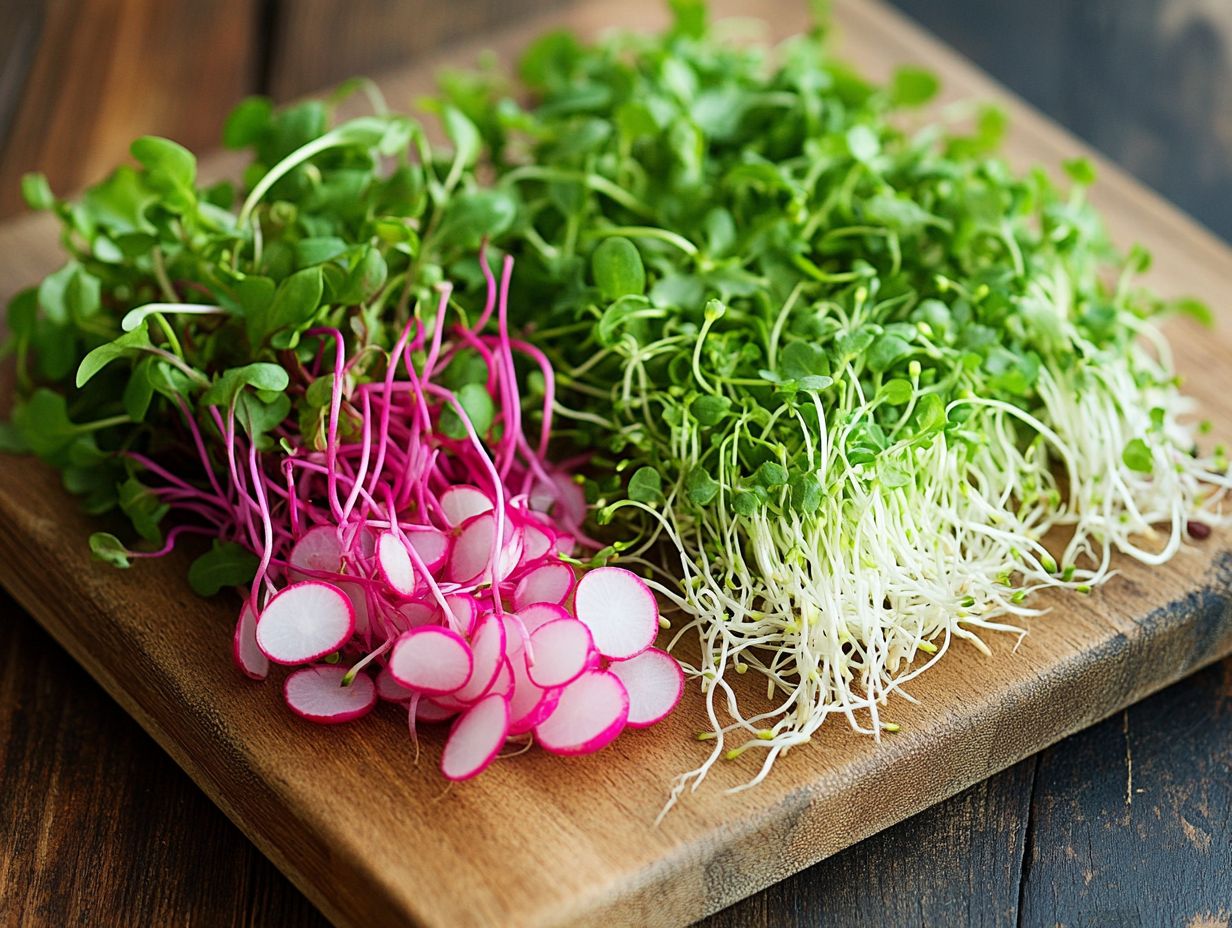
- Broccoli microgreens are packed with fiber and antioxidants, making them a great choice for weight loss.
- Kale microgreens are low in calories and high in nutrients, making them an excellent addition to any weight loss diet.
- Arugula microgreens have a peppery flavor and can help boost metabolism, thanks to their rich content of polyphenols.
1. Broccoli Microgreens
Broccoli microgreens are true powerhouses of concentrated nutrients. They offer a myriad of health benefits, including cancer prevention and heart health support.
Research published in the Journal of Agricultural and Food Chemistry highlights the impressive effects these microgreens have on various health conditions. They play a role in managing blood sugar and supporting gut health.
Broccoli microgreens contain sulforaphane, which may help inhibit tumor growth, adding another layer of defense against cancer.
Their anti-inflammatory properties can help lower cholesterol levels and enhance blood circulation, contributing to heart health.
Additionally, their fiber content regulates blood sugar, making them a smart choice for those managing diabetes, particularly Type 2 diabetes. Add these tiny greens to your meals to improve your wellness journey.
2. Kale Microgreens
Kale microgreens are not just a delightful touch to your salads and smoothies; they also provide an impressive array of health benefits. They are rich in vitamin K, iron, and potent antioxidants.
These petite greens are vital in fighting iron deficiency, a common concern for many. Their impressive nutritional profile plays a significant role in boosting hemoglobin levels and enhancing overall vitality.
Studies suggest that the high concentration of phytochemicals, including sulforaphane, in kale microgreens may aid in managing chronic conditions like diabetes and heart disease.
Incorporating these microgreens into your daily diet bolsters your iron intake and invests in your long-term health, making them a worthy addition to any meal.
3. Arugula Microgreens
Arugula microgreens are a spicy, nutrient-dense delight that adds a distinctive flavor to your dishes. They offer significant health benefits, primarily due to their high polyphenol content, dietary fiber, and antioxidant properties.
These tiny greens are more than just a culinary treat; they are a formidable ally for your cardiovascular health. Packed with antioxidants, arugula microgreens can help lower cholesterol levels and reduce inflammation both crucial factors tied to heart disease.
Research, including studies from the Indian Journal of Medical Research and the Journal of Future Foods, underscores the vital role these microgreens play in supporting endothelial function and enhancing overall heart health. By incorporating arugula microgreens into your diet, you can take proactive steps toward disease prevention and cultivate a healthier lifestyle.
4. Cabbage Microgreens
Cabbage microgreens, part of the Brassicaceae family, are not just a culinary delight; they are also a powerhouse of health benefits. Their rich antioxidant content aids in cancer prevention.
These tiny greens are packed with vitamins C, E, and K, elevating your dishes with vibrant flavor. They play a vital role in supporting gut health, which is crucial for reducing the health risks associated with chronic diseases.
Recent studies featured in health journals reveal that the high fiber content found in cabbage microgreens enhances digestion and fosters a healthy microbiome. This is essential for warding off chronic diseases like diabetes and heart disease.
Their unique phytochemicals include sulforaphane, which is linked to reduced inflammation. This makes these microgreens an astute choice for anyone aiming to boost overall welfare, longevity, and cancer prevention. Try adding cabbage microgreens to your next meal for a delicious health boost!
5. Radish Microgreens
Radish microgreens, with their delightful peppery flavor and low-calorie profile, are more than just a culinary enhancement; they bring a wealth of health benefits to your table. They assist in glucose control and boast a rich antioxidant content, making them a smart choice for your diet.
Packed with essential nutrients like vitamins A, C, and K, radish microgreens serve as a powerhouse for anyone looking to boost their nutritional intake without piling on the calories. Research suggests that adding these microgreens to a balanced diet can aid in weight loss, thanks to their fiber content, which helps you feel fuller for longer. For those interested in enhancing their culinary creations, exploring the top microgreen varieties for gourmet cooking can add both flavor and nutrition to your meals.
Additionally, studies have indicated that their phytochemicals may improve insulin sensitivity, offering potential benefits for managing blood sugar levels. Whether you toss them into a salad, blend them into a smoothie, or use them as a garnish, radish microgreens are a versatile addition to any health-focused meal plan.
6. Pea Shoots Microgreens
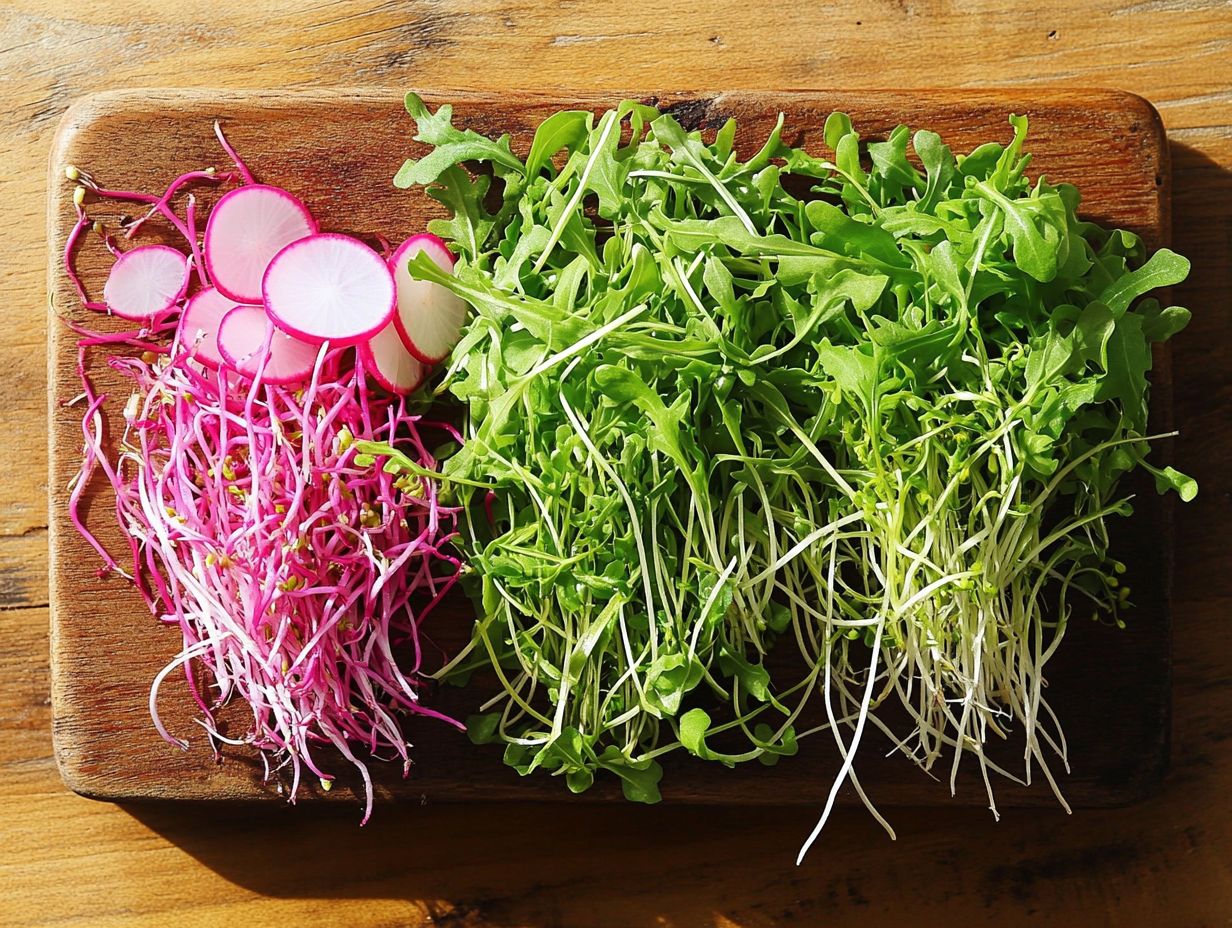
Pea shoots microgreens are a delightful addition to your culinary repertoire. They offer a wealth of essential amino acids, dietary fiber, and antioxidant properties beneficial for both heart health and overall wellness.
These tender greens bring a subtle sweetness to your dishes while being rich in vitamins A, C, and K nutrients that contribute to lowering LDL cholesterol and improving blood circulation.
By incorporating these microgreens into your meals, you’re not just enhancing flavor; you’re also boosting your dietary fiber intake. Research has shown a strong correlation between fiber consumption and a reduced risk of cardiovascular diseases, making this an important consideration for your health.
For example, a study published in the Journal of the American College of Cardiology suggests that higher fiber diets can lead to improved heart health outcomes. Thus, adding pea shoots to your salads, stir-fries, or even smoothies is not only a tasty choice but a smart one for promoting a heart-healthy diet.
7. Mustard Microgreens
Mustard microgreens are not just a burst of flavor; they re also packed with polyphenols, natural compounds found in some vegetables that may help prevent disease, and antioxidant properties. This makes them a remarkable choice for anyone focused on cancer prevention and overall health.
These petite greens offer impressive anti-inflammatory benefits that can elevate your diet. Research indicates that compounds found in mustard microgreens, like glucosinolates, may help lower inflammation markers in your body, promoting improved heart health and overall wellness.
Incorporating these vibrant greens into your meals whether in salads, smoothies, or as garnishes allows you to enjoy essential nutrients without piling on the calories. Studies published in dietary journals emphasize that a diet rich in microgreens bolsters immune function and lowers the risk of chronic diseases.
Don t miss out on adding these microgreens to your meals for a healthier you!
8. Sunflower Microgreens
Sunflower microgreens are a delightful addition to your cooking! They have a crunchy texture and vibrant flavor. Plus, they are rich in antioxidants and low in calories.
Not only do they taste great, but they also support heart health. With high dietary fiber, they help you feel full, which can prevent overeating.
Research shows these microgreens may help lower harmful cholesterol levels and improve circulation. This is great for your heart health.
With such remarkable properties, sunflower microgreens aren’t just tasty; they re a powerful ally for a healthy lifestyle.
9. Beet Microgreens
Beet microgreens are known for their vibrant hue and delightful sweetness. They are packed with nutrients and help fight iron deficiency, making them a great choice for improving vitality and managing diabetes.
These striking greens also deliver an impressive array of nutrients, including vitamins A, C, and K. Studies show they are an excellent source of iron, making them beneficial for overall health.
Their fiber content supports digestion and promotes the growth of beneficial bacteria in your gut. Adding these nutrient-dense microgreens to your diet can improve iron levels and gut function, perfect for a balanced eating plan.
10. Watercress Microgreens
Watercress microgreens are celebrated as a superfood due to their potent antioxidant properties and high dietary fiber content. They are significant allies in cancer prevention and overall health.
These tiny greens are loaded with essential vitamins and minerals, packing more nutrients than mature plants. They can combat oxidative stress, a major factor in chronic diseases.
Research suggests that incorporating watercress microgreens into your meals can help lower blood pressure and enhance heart health due to their rich flavonoids and phytochemicals.
How Do Microgreens Aid in Weight Loss?
Microgreens are a great addition to your weight loss diet! They offer low-calorie options rich in dietary fiber, which helps control glucose levels and promotes a sense of fullness.
These tiny plants are full of vitamins, minerals, and antioxidants, making them nutrient-dense despite their small size. Incorporating microgreens into your meals enhances your nutritional profile without adding many calories.
Research shows that fiber-rich foods boost feelings of fullness and help reduce calorie intake. One study found that participants who included high-fiber microgreens reported lower hunger levels and made healthier meal choices.
This makes microgreens not just a colorful addition to your salads and smoothies, but also a smart strategy for sustainable weight loss! Consider incorporating the top 5 microgreens for smoothies into your diet for added health benefits!
What Are the Nutritional Benefits of Microgreens?
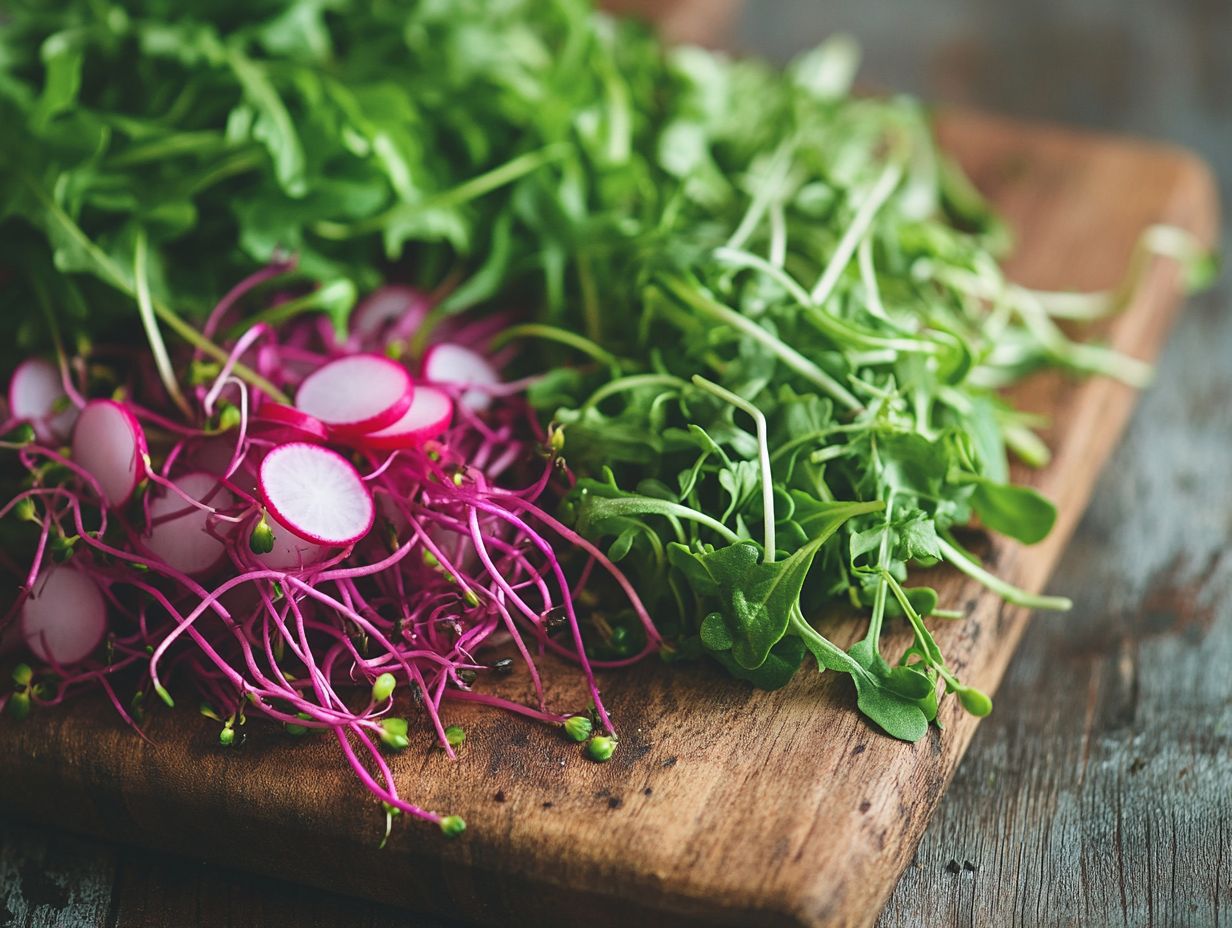
Microgreens are a superfood packed with concentrated nutrients. They offer impressive health benefits, including high levels of antioxidants and polyphenols that help prevent diseases.
These tiny greens, like arugula, radish, and mustard, are rich in vitamins and minerals. Research shows they often contain significantly more essential nutrients than their fully grown counterparts.
For instance, a study in the Journal of Food Science reveals that some microgreens can have up to 40 times more vitamins C and E than mature vegetables.
This high nutrient content makes microgreens a valuable addition to your diet. They support heart health, improve digestion, and enhance your immune system and they taste great!
How Can Microgreens Be Incorporated into a Weight Loss Diet?
Using microgreens in your weight loss diet is an exciting and nutritious choice. They add flavor, color, and are low-calorie and high-fiber.
These greens can transform simple dishes like salads and smoothies. Imagine a hearty quinoa salad topped with pea shoots and radish microgreens; it’s not just eye-catching it’s packed with nutrients!
Adding microgreens to your meals can help with weight management. They are rich in vitamins yet low in calories, inviting creativity and health benefits into your cooking.
Are There Any Risks or Side Effects of Consuming Microgreens?
Microgreens are generally safe and nutritious. However, if you have dietary restrictions or iron deficiency, be aware of potential health risks.
Some people might experience issues due to the high levels of oxalates in certain varieties. These can affect calcium absorption and pose risks for those with kidney stones.
If you have a compromised immune system or health issues, be cautious, as microbial contamination can occur during growth. Always wash them thoroughly, and choose certified organic sources.
Before significantly increasing your microgreen intake, consult a healthcare provider, especially if you have chronic health conditions.
What Are the Different Ways to Grow Microgreens at Home?
Growing microgreens at home is an enjoyable way to boost your nutrition. You can cultivate your own fresh produce easily.
Choose between soil-based methods or hydroponic systems for this rewarding experience. Soil-based techniques use nutrient-rich potting mix, while hydroponics fit even the tiniest spaces, perfect for urban gardeners.
The advantages of home gardening go beyond fresh flavors. Incorporating microgreens into your meals can significantly boost your nutrient intake for a healthier diet.
Can Microgreens Be Used in Recipes for Weight Loss?
Microgreens are a flexible food that you can easily add to your weight loss recipes. They offer tasty, low-calorie options packed with health benefits.
These tiny, nutrient-dense greens can elevate the nutritional profile of your meals. Whether you sprinkle them on fresh salads for a satisfying crunch or blend them into smoothies for a vibrant burst of flavor, they provide essential vitamins that your body craves. You can add microgreens to your daily meals to promote healthier eating habits. For a great start, consider the top 5 microgreen varieties for breakfast. Not only are they low in calories, but they are also rich in antioxidants and essential nutrients.
A study published in a nutrition journal shows that adding microgreens to your meals can make you feel fuller, potentially leading to reduced overall calorie consumption. This makes them an excellent choice for anyone wanting to shed pounds while still enjoying delicious meals.
Frequently Asked Questions
1. What are microgreens and how can they aid in weight loss?
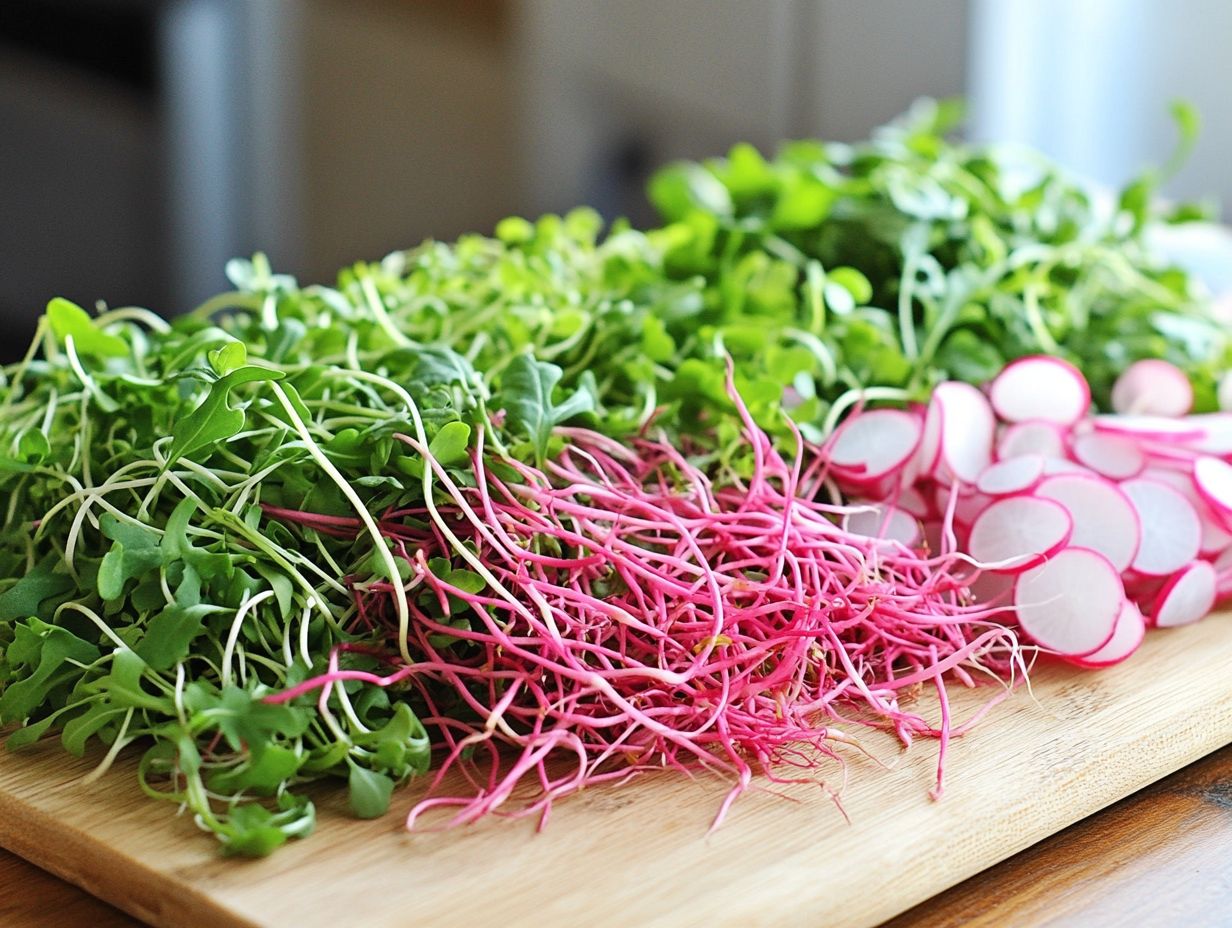
Microgreens are young vegetable greens harvested after the first true leaves have developed. They are packed with essential nutrients and can help in weight loss by providing a low-calorie, nutrient-rich addition to your meals.
2. What are the top 10 microgreens for weight loss?
The top 10 microgreens for weight loss are broccoli, kale, spinach, radish, watercress, arugula, chia, cilantro, beet, and mustard. These microgreens are low in calories and high in nutrients, making them ideal for a weight loss diet.
3. How do microgreens help in maintaining a healthy weight?
Microgreens are rich in fiber, which promotes satiety and reduces appetite. They also contain low amounts of carbohydrates and calories, making them great for those looking to manage their weight.
4. Can microgreens be consumed as a standalone meal for weight loss?
No, microgreens should not be consumed as a standalone meal for weight loss. While they are nutrient-dense, they do not provide enough calories and macronutrients for a complete meal. They should be included in a well-balanced diet for optimal weight loss results.
5. How can I incorporate microgreens into my meals for weight loss?
Microgreens can be added to salads, sandwiches, wraps, soups, smoothies, or used as a garnish for main dishes. They can also replace high-calorie ingredients like cheese or croutons, making your meals healthier and more weight-loss friendly.
6. Are there any cautions to be taken while consuming microgreens for weight loss?
There are no specific cautions for consuming microgreens for weight loss. However, it is important to ensure that microgreens are properly washed before consumption to avoid potential foodborne illnesses. Individuals with certain allergies or medical conditions should consult a doctor before including microgreens in their diet.


